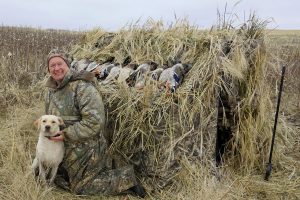New York’s Waterfowl season

Veteran waterfowler Jim Miller and rookie retriever Rosalee (aka the White Kraken) with a nice bunch of mallards. Provided photo
I am going out on a limb here and declaring waterfowl hunters the craziest of all sportsmen. Ice fishermen are a close second and archery deer hunters can put every waking moment into harvesting a big buck, but when it comes to straight up insane tactics, duck hunters win. I know… I’m one of them.
I just got back from driving 36 hours one way up into Saskatchewan just to spend a week hunting ducks and geese, and this is my tenth time pulling off this outlandish drive. The things waterfowlers do just to shoot at a duck or goose are hard to justify to sane people. Let’s face it, anyone who thinks that getting out in a marsh in the pre-dawn darkness, wading in waist-deep mud with a light on your head to strategically place their decoys … all while a half-crazed retriever full of adrenaline is running around crazy getting mud all over everything is fun is just not all there. And that’s just a drop in the bucket as far as examples of the crazy behaviors that non-believers would be shocked by.
Western New York has a rich heritage of waterfowl hunting that goes back centuries due to the abundance of lakes and rivers we have in this region. Where there is water there are waterfowl. Even now there are thousands of waterfowlers in the area and there is still some good hunting to be had here; although due to the fact that we are losing waterfowl habitant at an alarming rate, the overall waterfowl numbers are slowly shrinking each season.
The western zone waterfowl season in our area opened on October 27. By all early accounts the duck numbers are down and the goose numbers up. These reports are not official, but based on feedback I get from the hunters in the area.
We have some good duck hunting in this region, especially in the marshes along Lake Ontario and the Finger Lakes. Additionally, the migrator Canadian geese are showing up in the cut corn fields in the area.
The regulations for waterfowl are completely different than other game laws in the state because they are federally regulated. The feds give the Department of Environmental Conservation in New York State guidelines that the state must abide by. Many of the waterfowl guidelines are not in the hunting regulations booklet because it is printed before they are finalized by the D.E.C. To get the current regs, you can call the Region 8 office in Avon: 585-226-5380 or go to D.E.C. website http://www.de.ny.gov/outdoors.
One of the major differences is that you can shoot a half hour before sunrise. Also, you must use steel shot. Thirdly, your shotgun must hold only three shells. If you have a pump or a semi-auto, you will need a plug in your gun. Also, you must have a duck stamp that can be purchased at most post offices, an H.I.P. number is required. You can get one by calling 888-427-5447 or online at http://www.ny-hip.com/.
The problem with waterfowl hunting is that it’s a hard sport to pick up on your own. Your best bet is to find somebody to hunt with at least for the first few hunts. There are just too many specific regulations, not to mention the equipment needed and, even more important, a spot to hunt. Try to find an experienced waterfowler and ask if he will let you tag along. Most are very secretive, but if you can convince them that you won’t spill the beans on where they hunt and are willing to do the hard work, you might be able to ride along. Many can use any extra manpower. You will get muddy, your vehicle will get muddy inside and out, and all your gear from your gun to your socks will get muddy or wet. It is not a sport for the outdoor catalog pretty boys.
Unlike deer (gun) hunting where we all know a casual hunter who has taken a nice deer by pure luck alone, this does not happen in waterfowl hunting and that makes it one of the most rewarding hunts. There is very little luck involved with success.
Identifying the ducks on the wing is one of the most intimidating things for a new hunter. The mallard is the most common duck in our area and I would venture an educated guess that 70 percent of the ducks you will see in the early season will be mallards. Telling a drake from a hen is very important because you can only shoot two hens a day. But if you shoot all drakes you can shoot four, so it pays to be able to tell the difference on the wing. There is some great stuff on YouTube that will help you I.D. your ducks on a wing. This is a mandatory skill if you want to be a duck hunter.
Geese on the other hand are simple to ID. The only problem is that there is no way for a hunter to distinguish between a male and female on the wing or even in hand for that matter.
Here in the Western Zone, the duck season runs from October 27 though December 8, and then it reopens on December 26 though January 11. The daily limit of six ducks includes no more than four mallards (two of which may be hens), three wood ducks, two black duck, one pintail, two scaup (bluebills), two redheads, two canvasbacks, four scoters, four eiders, four long-tailed ducks or two hooded mergansers, all mergansers and sea ducks (scoters, eiders and long-tailed ducks). For all other duck species found in New York, the daily limit is six. The Canada goose season runs from October 27 through November 26 and reopens December 26 through January 13 with a three-bird daily limit.
So, if you are a masochist with a sense of adventure you might like waterfowl hunting. If so, you need to find someone that hunts ducks and geese and see if you can join them. Just be careful, it can get in your blood and the next thing you know you will be waist deep in a quagmire with a muddy lab shaking muck all over while you crouch in the cattails hoping that today will be the day it will rain waterfowl.



